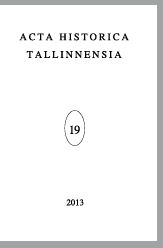EESTI NSV TÖÖSTUSE ARENG SEITSEAASTAKUL (1959–1965) RAHVAMAJANDUSE NÕUKOGU REFORMI TAUSTAL
DEVELOPMENT OF INDUSTRY IN THE ESTONIAN SSR UNDER THE SEVEN YEAR PLAN (1959–1965) IN THE CONTEXT OF THE NATIONAL ECONOMIC
Author(s): Maie PihlamägiSubject(s): History
Published by: Teaduste Akadeemia Kirjastus
Summary/Abstract: The seven year plan was formulated and implemented in the period when an industrial management reform in the USSR was underway. The reform, which became known as the National Economic Council (NEC) reform, was aimed to decentralize the management of industry, including the construction industry. This reform was driven by the need for changes in the industrial sector in order to accelerate economic growth. Nevertheless, the freedom of the new administrative body, the National Economic Council, to make its own decisions on industrial matters was limited by the centrally established rules. General industrial development trends and production volumes were prescribed by the directives from Moscow. The task of the republican NECs was to increase the managerial efficiency by quickly solving the local economic problems and taking all measures to exploit local resources for the fulfilment of the plan targets. Expectations for the seven year plan were high. The plan was expected to guide the country to greater social and economic progress. The high-spirited seven year plan was based on the desire of the political leaders to make the USSR the greatest industrial power rather than on the real economic situation and opportunities for industrial development. The industrial output of the Estonian SSR was to increase 1.8-fold on the base of productivity growth. Higher productivity was to be achieved by the implementation of new technology and techniques and rapid development of automation. The Estonian SSR like Latvia and Lithuania had also to make huge contributions to the fishing industry of the USSR, as well as to the chemical industry of the USSR, in order to eliminate the backwardness in these areas. In addition, the Estonian SSR had the task to supply electrical energy for the northwestern region of the Soviet Union. According to the seven year plan, the Estonian SSR had to focus on the development of oil shale-based power engineering, building materials, engineering, fishing and fish processing industries. During the seven year plan period the industry faced many problems inherited from the era of five year plans. The industrial and construction management reform could not resolve these problems. As the economic system remained unchanged and the new management system continued to prefer administrative methods to economic methods, all the problems inherent in a command economy persisted. One of the most important problems was related to planning. The excessively large number of plans made their coordination and management difficult, especially because the plans were frequently changed. The fact that some plan parameters were changed while other, related parameters remained unaltered caused a lot of confusion. Industrial enterprises themselves had little influence on the drafting of their development plans. The system of plan indicators was too detailed; moreover, numerous indicators were fixed by a higher authority.
Journal: Acta Historica Tallinnensia
- Issue Year: 2013
- Issue No: 19
- Page Range: 115-146
- Page Count: 32
- Language: Estonian

